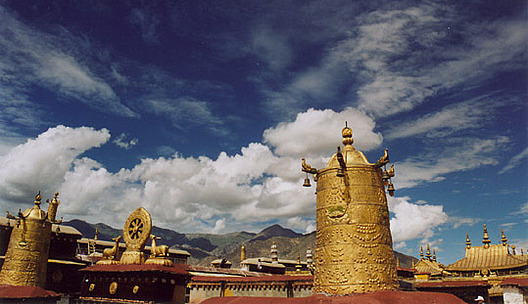This was my first time in Tibet, from June 19 to July 7, 2002. Tibet occupies the highest plateau on earth, where all major rivers on the Asian mainland trace their sources to; it is a very large, sparsely populated land. The core regions of Tibet constitute Tibetan Autonomous Region of China. Outlying Tibetan regions are incorporated in four neighboring Chinese provinces: Qinghai and Gansu (Amdo region), Sichuan and Yunnan (Kham region). All Tibetans follow Tibetan Buddism (also known as Tantric Buddhism), which is also practiced by Tibetan-related peoples of Bhutan, Sikkim and Ladakh (both are a part of India), parts of Nepal, as well as Mongolians and related peoples in China, Mongolia and Russia.
We arrived in Lhasa by plane from the Chinese city of Chengdu, the capital of Sichuan province. From the plane window I saw astounding huge mountain ranges marching to the horizon, one after another in un-ending sequence. I also recognized the sharp snow-capped spire of Minya Konka, 7556 m./24,790 ft., the easternmost of Tibet's highest peaks.
The first day I experienced light headache, a reaction to the altitude of Lhasa which is over 3600 m./11,700 ft. (Over the course of the trip I suffered from severely chaffed and bleeding lips due to the excessively dry air here. The symptom only went away when I descended to lower altitudes.) The midday sun was overbearing, but more comfortable in the late afternoon. The sunset scene was beautiful on the bank of the wide, peaceful Lhasa River (Kyi Chu), backed by a continuous range of massive peaks soaring to 1800 m./ 6000 ft. above the valley.
The Barkhor neighborhood of east Lhasa around Jokhang Temple is bustling all the time with pilgrims from everywhere, many in colorful traditional dress and wearing lots of jewelery. The place is full of merchants selling a wide variety of exuberant ornaments and handicraft items, all with religious symbolism. I was astounded by all kinds of lavishly beautiful artistic and religious expression of Tibetans, on clothes, ornaments, doors and windows, curtains and awnings, murals everywhere (all interior walls and some ceilings in the hotel I stayed at), even the top of trucks are adorned with rich assemblages of carved religious symbols. Arguably Tibetans are the most devoutly religious: many pilgrims took months to travel here by primitive means (some perform full-body prostration at every step for 1000 miles), then give all their wealth to the monasteries here.
Modernity is part of Lhasa and Tibetan people as well. I was somewhat surprised that almost all businesses (hotels, stores, tourist agencies, etc.) I dealt with were staffed and supervised by Tibetans, only restaurants have a bigger Chinese presence. All of these Tibetans spoke good Chinese (Mandarin), and quite a few spoke a little English. Lhasa Tibetans are a sophisticated bunch, friendly, well-mannered, optimistic, always dignified, often philosophical. My impression of Lhasa is truly a vibrant, enchanting, and quintessentially Tibetan city.
Jokhang Temple, the oldest and holiest shrine in Tibet, was built 1400 years ago in the heart of the city. The top of Jokhang is adorned with several gold-gilded roofs and many glittering golden religious objects. From the top there is a fabulous 360 degree view of the city, along with a fine view of Potala Palace occupying a commanding hill top. There we witnessed Tibetan workers singing and dancing in rhythm while stomping on a freshly mortared part of the roof.
Potala Palace, the former seat of the Dalai Lamas, is the largest fortress and palace complex in Tibet. It is a spellbinding, majestic structure, topped by golden roofs. Inside are countless magnificent treasures and relics, including huge funerary stupas of past Dalai Lamas. The 5th Dalai Lama has the largest, 4 story high stupa which was built using nearly 4 tons of gold and innumerable gems. In the upper courtyard of the Potala a team of artisans were repairing a huge thangka, the traditional type of embroidered wall hanging depicting religious images. This thangka was too big to fit in the courtyard, which was at least 100 feet/30 m long and wide. The thangka will be hung from the huge front wall of the Potala fortress during a religious festival.
Sera Monastery, along with Drepung and Ganden monasteries, were the "big three" Gelugpa sect monasteries near Lhasa. Drepung at one time was the largest monastery in the world with more than 10,000 monks. Throughout Tibet most monasteries were severely damaged or destroyed in the 60's and 70's. However, I saw no ruins at all at the big monasteries here, and most of the interior statues, murals, and other relics are in exquisitely beautiful shape, apparently due to massive rebuilding and restoration work going on since the 80's, partially financed by the Chinese government. Sera Monastery is a veritable city onto itself nestled at the foot of a large granite peak on the edge of Lhasa. Here we witnessed a theological debating session, which took place in the afternoon in a shaded courtyard. Hundreds of monks clad in dark red robes quizzed each other in pairs, employing a distinctive hand-clapping gesture. Behind the monastery some granite boulders have been painted with large, exquisite religious images in brilliant colors.

